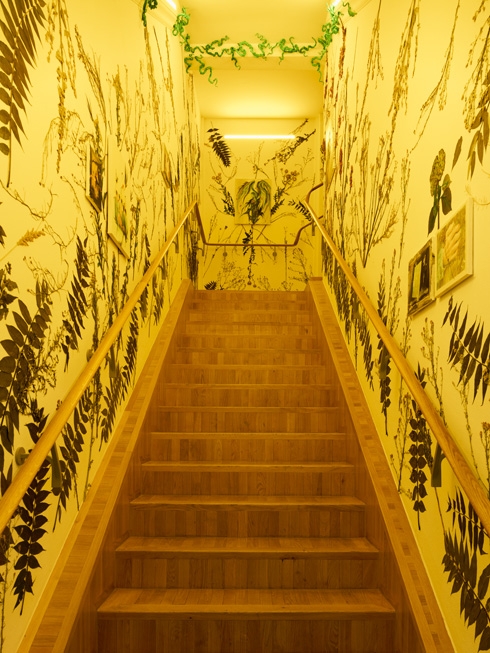The stairwell linking the Secession’s foyer to the gallery showing Korakrit Arunanondchai’s videowork has been frescoed with long-stemmed green leaves and branches that curve up and over the walls and ceiling. The effect, for visitors still shaking off the Viennese drizzle, is to infuse this sterile connecting space with a resuscitating warmth and wildness. Onto this trompe l’oeil trellis (which chimes with the gilded foliage on the building’s famous dome) are hung several small unframed paintings executed in a naive style. They include portraits of the artist’s grandmother at rest and a winged figure whose slicked-back hair and green body paint suggest Arunanondchai’s occasional collaborator, the similarly attired performance artist Boychild. Both the portraits and the mural in which they are entwined incorporate dried flowers.
It seems apt that an artist so preoccupied with linking cultures, spaces and states of mind should use an interstitial space to join his life with art. The desire to integrate also drives the Bangkok-born, New York-based artist’s together with history in a room filled with people with funny names (2012–), screened in the darkened upstairs gallery. This regularly updated record of the artist’s life – realised through episodic narratives that fictionalise his experience, incorporating cameos from friends and family members – combines sincerity and irony, spiritualism and scepticism.
I enter during the third of five episodes in this ‘living archive’, presented here as a looping series on a single large screen. The artist’s surrogate is dousing himself in paint before pressing his bare torso onto a strip of denim, a routine inspired by the young woman who became a sensation after doing the same on 2012’s Thailand’s Got Talent. It prompts the question of whether this figure – who seems in some respects to embody an archetype of the heroic male painter now out of fashion, in others to subvert the related hierarchies of male/female and subject/object – is to be taken seriously. The answer, here and throughout the other short videos in this evolving archive, might be yes and no. The narrative shuttles between different registers and contexts: invocations of an omniscient being (or machine) called Chantri are juxtaposed with documentary footage of the artist’s ailing grandmother; fictional interludes featuring the artist’s twin brother interleaved with recordings of a startling performance by Boychild. By turns funny and moving, pseudy and irreverent, the effect is to disarm critical expectations.
That together with history is engaging, affective and eminently likeable makes the watcher more inclined to accommodate the sometimes-sophomoric speculations delivered in voiceover. The exhibition literature, for instance, informs the audience that denim serves here to symbolise how materials and ideas move across borders; but that serge de Nîmes was named for a specific place might also reveal how meanings are lost in translation. That contradictions are symptoms of binary thinking – and that Arunanondchai is frequently cited as challenging such separations – doesn’t make them go away. Instead their framing within a narrative means that the viewer is willing to dwell on them: to use these points of friction or irresolution, as happens in every philosophical and scientific tradition, as catalysts for creative thought.
Ultimately, together with history is less a coherent philosophical programme than a revealing document of a young artist’s evolution. This is to its credit. The work’s spirit of openness prompts the idea that we might be advised to interpret the world and other people generously, to look for and share connections, and to act always in good faith, even if that faith must partially be blind. Which is to say that, in an age of complexity, anger and division, the thread that binds us is compassion. Sounds sensible to me.
Korakrit Arunanondchai, Secession, Vienna, 13 September – 10 November 2019
From the Winter 2019 issue of ArtReview Asia
